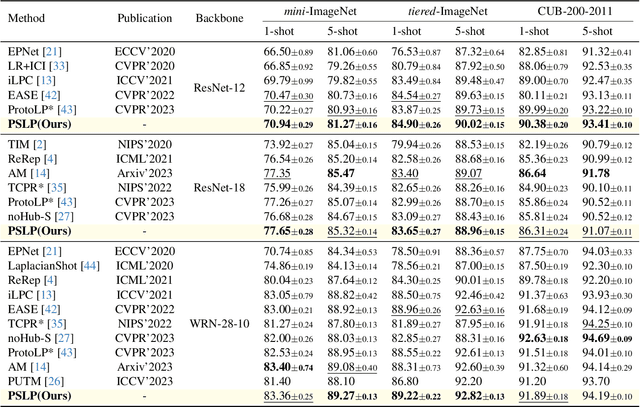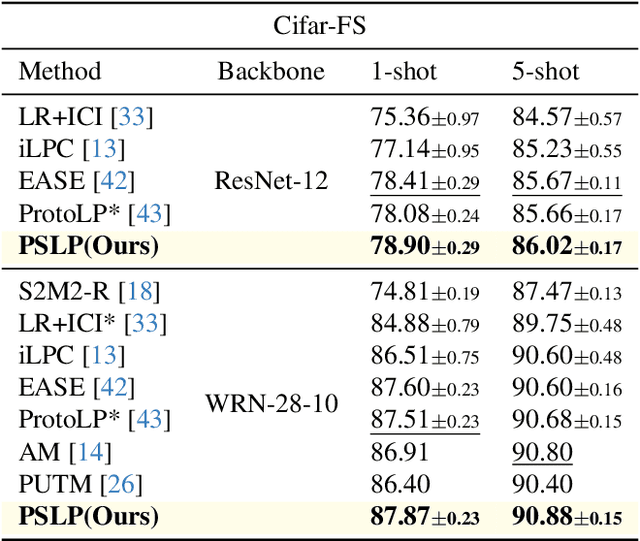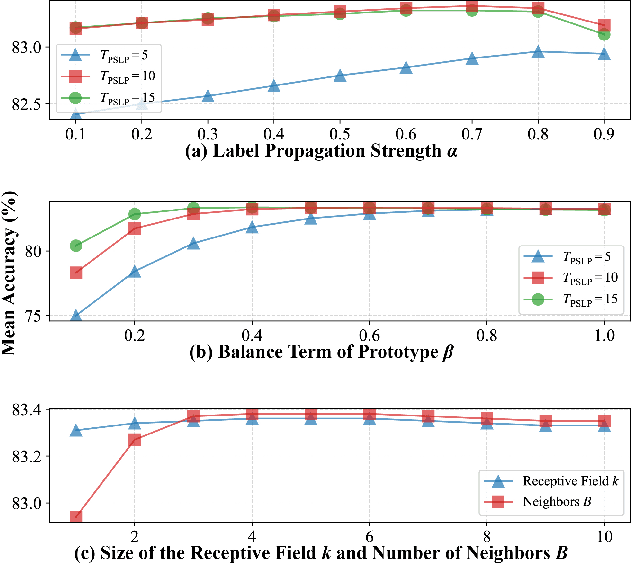Bin Luo
Robust Transductive Few-shot Learning via Joint Message Passing and Prototype-based Soft-label Propagation
Nov 28, 2023



Abstract:Few-shot learning (FSL) aims to develop a learning model with the ability to generalize to new classes using a few support samples. For transductive FSL tasks, prototype learning and label propagation methods are commonly employed. Prototype methods generally first learn the representative prototypes from the support set and then determine the labels of queries based on the metric between query samples and prototypes. Label propagation methods try to propagate the labels of support samples on the constructed graph encoding the relationships between both support and query samples. This paper aims to integrate these two principles together and develop an efficient and robust transductive FSL approach, termed Prototype-based Soft-label Propagation (PSLP). Specifically, we first estimate the soft-label presentation for each query sample by leveraging prototypes. Then, we conduct soft-label propagation on our learned query-support graph. Both steps are conducted progressively to boost their respective performance. Moreover, to learn effective prototypes for soft-label estimation as well as the desirable query-support graph for soft-label propagation, we design a new joint message passing scheme to learn sample presentation and relational graph jointly. Our PSLP method is parameter-free and can be implemented very efficiently. On four popular datasets, our method achieves competitive results on both balanced and imbalanced settings compared to the state-of-the-art methods. The code will be released upon acceptance.
WordArt Designer: User-Driven Artistic Typography Synthesis using Large Language Models
Oct 20, 2023



Abstract:This paper introduces "WordArt Designer", a user-driven framework for artistic typography synthesis, relying on Large Language Models (LLM). The system incorporates four key modules: the "LLM Engine", "SemTypo", "StyTypo", and "TexTypo" modules. 1) The "LLM Engine", empowered by LLM (e.g., GPT-3.5-turbo), interprets user inputs and generates actionable prompts for the other modules, thereby transforming abstract concepts into tangible designs. 2) The "SemTypo module" optimizes font designs using semantic concepts, striking a balance between artistic transformation and readability. 3) Building on the semantic layout provided by the "SemTypo module", the "StyTypo module" creates smooth, refined images. 4) The "TexTypo module" further enhances the design's aesthetics through texture rendering, enabling the generation of inventive textured fonts. Notably, "WordArt Designer" highlights the fusion of generative AI with artistic typography. Experience its capabilities on ModelScope: https://www.modelscope.cn/studios/WordArt/WordArt.
VcT: Visual change Transformer for Remote Sensing Image Change Detection
Oct 17, 2023Abstract:Existing visual change detectors usually adopt CNNs or Transformers for feature representation learning and focus on learning effective representation for the changed regions between images. Although good performance can be obtained by enhancing the features of the change regions, however, these works are still limited mainly due to the ignorance of mining the unchanged background context information. It is known that one main challenge for change detection is how to obtain the consistent representations for two images involving different variations, such as spatial variation, sunlight intensity, etc. In this work, we demonstrate that carefully mining the common background information provides an important cue to learn the consistent representations for the two images which thus obviously facilitates the visual change detection problem. Based on this observation, we propose a novel Visual change Transformer (VcT) model for visual change detection problem. To be specific, a shared backbone network is first used to extract the feature maps for the given image pair. Then, each pixel of feature map is regarded as a graph node and the graph neural network is proposed to model the structured information for coarse change map prediction. Top-K reliable tokens can be mined from the map and refined by using the clustering algorithm. Then, these reliable tokens are enhanced by first utilizing self/cross-attention schemes and then interacting with original features via an anchor-primary attention learning module. Finally, the prediction head is proposed to get a more accurate change map. Extensive experiments on multiple benchmark datasets validated the effectiveness of our proposed VcT model.
DCPT: Darkness Clue-Prompted Tracking in Nighttime UAVs
Sep 19, 2023Abstract:Existing nighttime unmanned aerial vehicle (UAV) trackers follow an "Enhance-then-Track" architecture - first using a light enhancer to brighten the nighttime video, then employing a daytime tracker to locate the object. This separate enhancement and tracking fails to build an end-to-end trainable vision system. To address this, we propose a novel architecture called Darkness Clue-Prompted Tracking (DCPT) that achieves robust UAV tracking at night by efficiently learning to generate darkness clue prompts. Without a separate enhancer, DCPT directly encodes anti-dark capabilities into prompts using a darkness clue prompter (DCP). Specifically, DCP iteratively learns emphasizing and undermining projections for darkness clues. It then injects these learned visual prompts into a daytime tracker with fixed parameters across transformer layers. Moreover, a gated feature aggregation mechanism enables adaptive fusion between prompts and between prompts and the base model. Extensive experiments show state-of-the-art performance for DCPT on multiple dark scenario benchmarks. The unified end-to-end learning of enhancement and tracking in DCPT enables a more trainable system. The darkness clue prompting efficiently injects anti-dark knowledge without extra modules. Code and models will be released.
Refined Temporal Pyramidal Compression-and-Amplification Transformer for 3D Human Pose Estimation
Sep 06, 2023Abstract:Accurately estimating the 3D pose of humans in video sequences requires both accuracy and a well-structured architecture. With the success of transformers, we introduce the Refined Temporal Pyramidal Compression-and-Amplification (RTPCA) transformer. Exploiting the temporal dimension, RTPCA extends intra-block temporal modeling via its Temporal Pyramidal Compression-and-Amplification (TPCA) structure and refines inter-block feature interaction with a Cross-Layer Refinement (XLR) module. In particular, TPCA block exploits a temporal pyramid paradigm, reinforcing key and value representation capabilities and seamlessly extracting spatial semantics from motion sequences. We stitch these TPCA blocks with XLR that promotes rich semantic representation through continuous interaction of queries, keys, and values. This strategy embodies early-stage information with current flows, addressing typical deficits in detail and stability seen in other transformer-based methods. We demonstrate the effectiveness of RTPCA by achieving state-of-the-art results on Human3.6M, HumanEva-I, and MPI-INF-3DHP benchmarks with minimal computational overhead. The source code is available at https://github.com/hbing-l/RTPCA.
PoSynDA: Multi-Hypothesis Pose Synthesis Domain Adaptation for Robust 3D Human Pose Estimation
Aug 18, 2023Abstract:The current 3D human pose estimators face challenges in adapting to new datasets due to the scarcity of 2D-3D pose pairs in target domain training sets. We present the \textit{Multi-Hypothesis \textbf{P}ose \textbf{Syn}thesis \textbf{D}omain \textbf{A}daptation} (\textbf{PoSynDA}) framework to overcome this issue without extensive target domain annotation. Utilizing a diffusion-centric structure, PoSynDA simulates the 3D pose distribution in the target domain, filling the data diversity gap. By incorporating a multi-hypothesis network, it creates diverse pose hypotheses and aligns them with the target domain. Target-specific source augmentation obtains the target domain distribution data from the source domain by decoupling the scale and position parameters. The teacher-student paradigm and low-rank adaptation further refine the process. PoSynDA demonstrates competitive performance on benchmarks, such as Human3.6M, MPI-INF-3DHP, and 3DPW, even comparable with the target-trained MixSTE model~\cite{zhang2022mixste}. This work paves the way for the practical application of 3D human pose estimation. The code is available at https://github.com/hbing-l/PoSynDA.
Towards Deeply Unified Depth-aware Panoptic Segmentation with Bi-directional Guidance Learning
Aug 14, 2023Abstract:Depth-aware panoptic segmentation is an emerging topic in computer vision which combines semantic and geometric understanding for more robust scene interpretation. Recent works pursue unified frameworks to tackle this challenge but mostly still treat it as two individual learning tasks, which limits their potential for exploring cross-domain information. We propose a deeply unified framework for depth-aware panoptic segmentation, which performs joint segmentation and depth estimation both in a per-segment manner with identical object queries. To narrow the gap between the two tasks, we further design a geometric query enhancement method, which is able to integrate scene geometry into object queries using latent representations. In addition, we propose a bi-directional guidance learning approach to facilitate cross-task feature learning by taking advantage of their mutual relations. Our method sets the new state of the art for depth-aware panoptic segmentation on both Cityscapes-DVPS and SemKITTI-DVPS datasets. Moreover, our guidance learning approach is shown to deliver performance improvement even under incomplete supervision labels.
Semantic-Aware Dual Contrastive Learning for Multi-label Image Classification
Jul 27, 2023Abstract:Extracting image semantics effectively and assigning corresponding labels to multiple objects or attributes for natural images is challenging due to the complex scene contents and confusing label dependencies. Recent works have focused on modeling label relationships with graph and understanding object regions using class activation maps (CAM). However, these methods ignore the complex intra- and inter-category relationships among specific semantic features, and CAM is prone to generate noisy information. To this end, we propose a novel semantic-aware dual contrastive learning framework that incorporates sample-to-sample contrastive learning (SSCL) as well as prototype-to-sample contrastive learning (PSCL). Specifically, we leverage semantic-aware representation learning to extract category-related local discriminative features and construct category prototypes. Then based on SSCL, label-level visual representations of the same category are aggregated together, and features belonging to distinct categories are separated. Meanwhile, we construct a novel PSCL module to narrow the distance between positive samples and category prototypes and push negative samples away from the corresponding category prototypes. Finally, the discriminative label-level features related to the image content are accurately captured by the joint training of the above three parts. Experiments on five challenging large-scale public datasets demonstrate that our proposed method is effective and outperforms the state-of-the-art methods. Code and supplementary materials are released on https://github.com/yu-gi-oh-leilei/SADCL.
Tracking Anything in High Quality
Jul 26, 2023Abstract:Visual object tracking is a fundamental video task in computer vision. Recently, the notably increasing power of perception algorithms allows the unification of single/multiobject and box/mask-based tracking. Among them, the Segment Anything Model (SAM) attracts much attention. In this report, we propose HQTrack, a framework for High Quality Tracking anything in videos. HQTrack mainly consists of a video multi-object segmenter (VMOS) and a mask refiner (MR). Given the object to be tracked in the initial frame of a video, VMOS propagates the object masks to the current frame. The mask results at this stage are not accurate enough since VMOS is trained on several closeset video object segmentation (VOS) datasets, which has limited ability to generalize to complex and corner scenes. To further improve the quality of tracking masks, a pretrained MR model is employed to refine the tracking results. As a compelling testament to the effectiveness of our paradigm, without employing any tricks such as test-time data augmentations and model ensemble, HQTrack ranks the 2nd place in the Visual Object Tracking and Segmentation (VOTS2023) challenge. Code and models are available at https://github.com/jiawen-zhu/HQTrack.
Sparse-Input Neural Network using Group Concave Regularization
Jul 01, 2023Abstract:Simultaneous feature selection and non-linear function estimation are challenging, especially in high-dimensional settings where the number of variables exceeds the available sample size in modeling. In this article, we investigate the problem of feature selection in neural networks. Although the group LASSO has been utilized to select variables for learning with neural networks, it tends to select unimportant variables into the model to compensate for its over-shrinkage. To overcome this limitation, we propose a framework of sparse-input neural networks using group concave regularization for feature selection in both low-dimensional and high-dimensional settings. The main idea is to apply a proper concave penalty to the $l_2$ norm of weights from all outgoing connections of each input node, and thus obtain a neural net that only uses a small subset of the original variables. In addition, we develop an effective algorithm based on backward path-wise optimization to yield stable solution paths, in order to tackle the challenge of complex optimization landscapes. Our extensive simulation studies and real data examples demonstrate satisfactory finite sample performances of the proposed estimator, in feature selection and prediction for modeling continuous, binary, and time-to-event outcomes.
 Add to Chrome
Add to Chrome Add to Firefox
Add to Firefox Add to Edge
Add to Edge